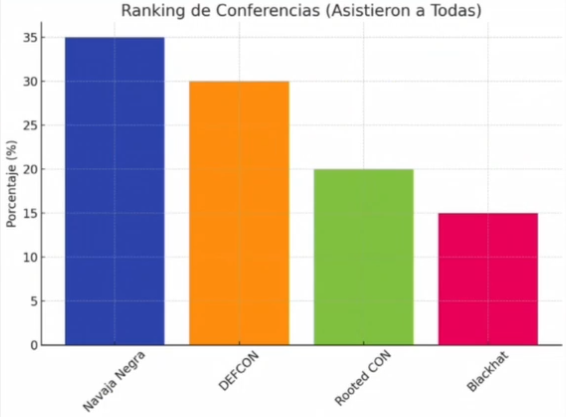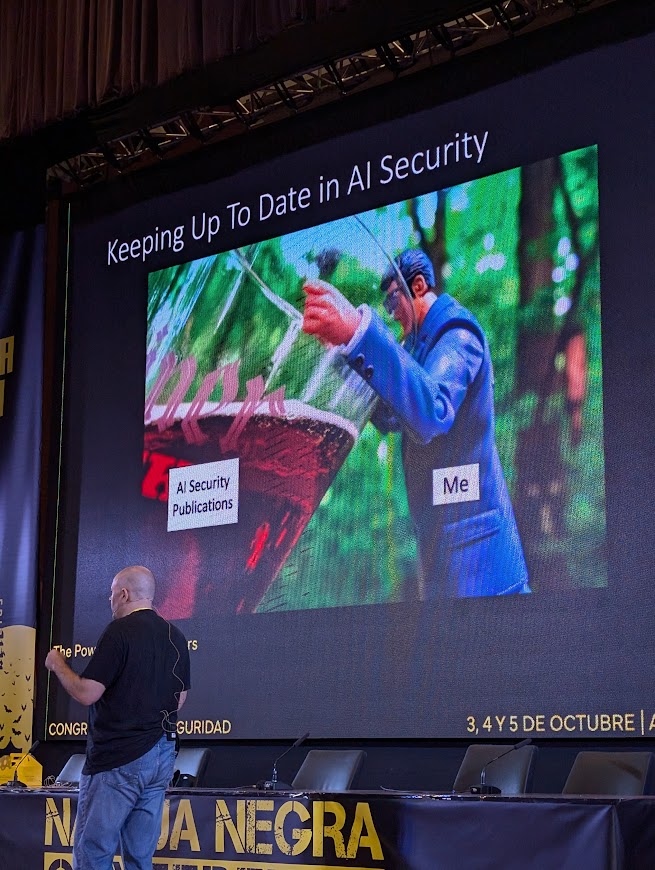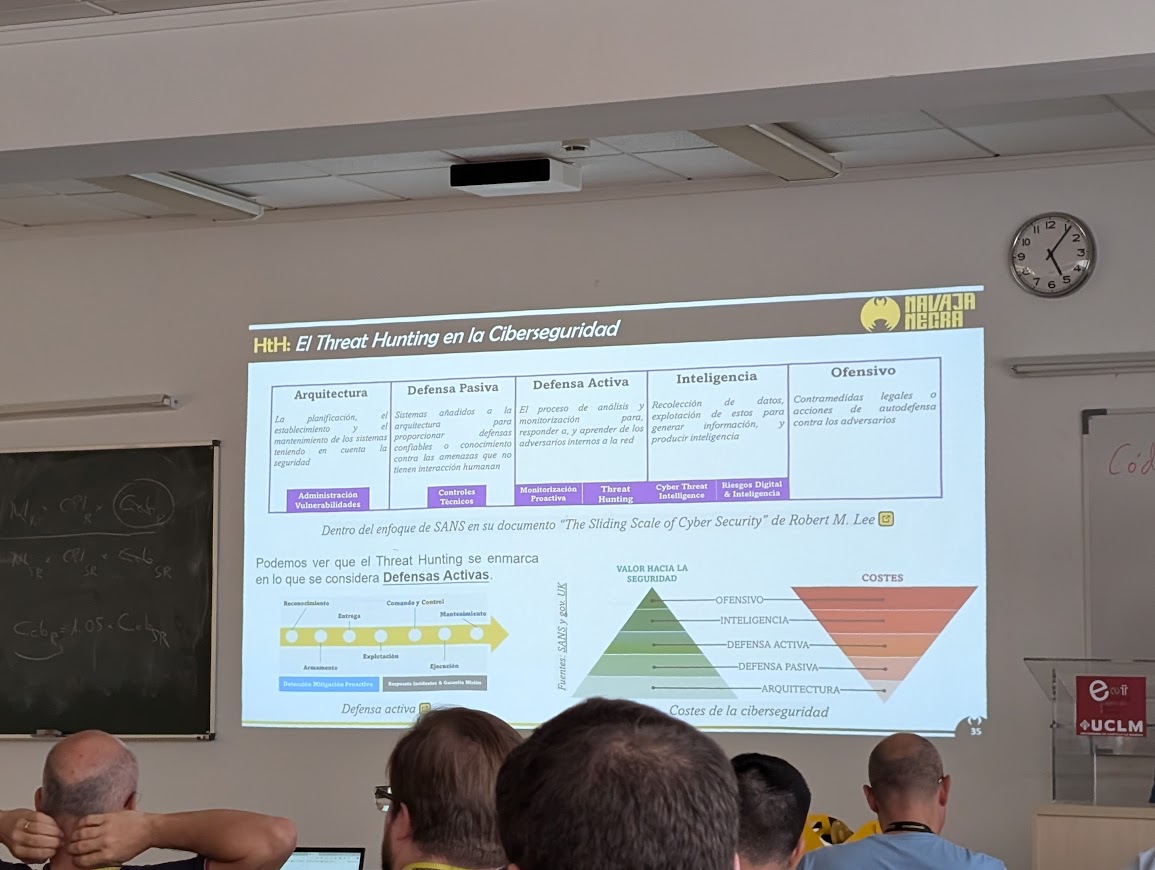Hack the knife
- EN
- ES
Table of Contents
Well, another Navaja Negra is over and that makes… four? five? I don’t even know.

Navaja Negra logo
#
navaja negra 2024 (12ed)
People don’t believe me when I say I’m going to a cybersecurity conference in Albacete:
― Albacete? ― Yes, it’s where the best cybersecurity conference in Spain (and beyond) takes place. What does Las Vegas have that Albacete doesn’t?
I wouldn’t trade it for anything, and if I can only attend one “con” a year, I want it to be this one. It’s on par with any of the well-known big ones in terms of quality, but none of them offer the same close-knit atmosphere or treat the attendees so well.
This year, Rubén Ródenas, the president of Navaja Negra organization, shared some behind-the-scenes details (thanks for the fascinating talk) and provided very interesting data about attendees’ preferences. Basically, I’m not the only one who prefers NN over DefCon:

Navaja Negra survey
Since the past few editions (2022, 2023?), you can follow the talks live on Twitch. For free. Are they crazy? No, their priority isn’t growth, it’s sharing knowledge. No one misses a talk!
The, why go?
For many reasons: first, because Albacete is cool. Lart year, by a fortunate series of events, I was able to spend a couple of extra days in the city, and it was a great idea that I recommend to anyone who can afford it.

Albacete is cool
Second, because there’s only one track. I hate conferences where there are n tracks and, what a coincidence, the n talks that interest me the most are always at the same time. Not only that, I always pick the wrong one. I have a gift for that.
There are also workshops and trainings for all levels. Yes, they run simultaneously with the talks, but since the talks are recorded and available online, you can choose a workshop (or two, or more) and watch the talks later.
Possibly in no other “con” is there such a close connection with the speakers. I love watching the talks, taking notes, and highlighting things I can ask the speakers when I run into them during the Navaja Negra nights.
Because that’s another point: the “nights.” Once the “official” sessions are over, the event continues in a nearby hotel lounge, where numerous activities take place, either organized by Navaja Negra, the sponsors, or spontaneously by the attendees. It’s the perfect setting for what other places call “networking,” but here it’s just having a few beers with colleagues. If it’s not the best part of the conference, it’s very close.
There’s only one thing that annoys me: the return train schedules. They don’t let me stay for the farewell lunch, which is a shame. But that’s on me, and next year I’ll try to organize things differently.
#
The talks
This year, I have decided to rate the talks, trying to establish a somewhat objective method (spoiler: impossible). This is what I evaluate:
| topic | description |
|---|---|
| innovation | Is the talk original, is it their own work, a rehash of other people’s research? |
| relevance | how important is the talk? How relevant is it? |
| presentation | Here I value the quality of the presentation/performance itself, whether the slides are cool, whether it is easy to follow, whether the speakers are fluent and easy-going and manage to keep the attention |
| timing | Was it too long, too short… Did the speaker have to run or did he/she have 20 minutes to waste (yes, it happened)? |
| adicional content | Has any additional stuff been delivered? Links, further reading…? Have they released any new artifact? Open source? |
I’m not going to share the results, but I will highlight the talks that scored the highest. And it’s surprising because some of them aren’t even remotely related to my main areas of knowledge, experience, or interest. But that’s what my rating system is for, and if a talk is awesome, it deserves to be recognized.
For example, the talk by @pancake, developer of Radare2, stood out as one of the best. In his presentation, he explained how to integrate different LLMs and/or AI services (commercial or running locally) to automate certain tasks within Radare2.
Another of my favourites was ‘The Power of Transformers’, by José Selvi on LLM risks. He gives a quick and dirty explanation of how transformers work in order to see how to exploit their weaknesses by means of prompt injection.

The risks of AI
I was really impressed by the talk given by Ainoa Guillén and Jorge Testa, cyber-intelligence analysts specialising in the underground and cybercrime. Very interesting and very well told about high-level cybercrime.
Another top-level talk (and there were many) was by Maurice Heumann, who came all the way from Karlsruhe to talk about Windows userspace emulation and his enormous work to implement full emulation, which will greatly facilitate not only DRM hacking (which is what he does at work) but also other activities such as malware analysis. The pity is that he doesn’t know if, once finished, he will release it as open source or as a commercial product.
This talk was part of the internatinoalization of the conference, which is a very good step in my opinion.
Alfonso Muñoz is a guarantee of an interesting talk about cryptography. He and David Ramírez (to whom he directed his TFM) talked about the possibility of creating cryptographic algorithms through the use of neural networks. The result could be the creation of single-use cryptographic algorithms.
Borja Martinez and Alejandro Hernando’s talk on UEFI attacks, TPM key extraction, DMA, etc. was as interesting as it was fun.
Also exciting was the talk by ReD, who talked about Deep Packet Inspection and how it is used in the Great Firewall of China for censorship.
I can’t help but mention the work of Rubén Ródenas to automate the resolution of recaptchav2 and the hilarious presentation with the most fucked-up ‘demo effect’ ever seen in the history of mankind.
And I’ve left out a lot; unfairly, but a lot of text already. And the workshops. And the academy. And the Miguelitos, doesn’t anyone think about the Miguelitos (spoiler: yes)?

A threat hunting workshop
#
Who is this conference for?
Well, for a lot of people, almost everyone; I think there are around 800 attendees, including students, enthusiasts, and all kinds of cybersecurity professionals: researchers, red teamers, blue teamers, reversers, many pentesters and even some clueless C-levels who have taken off their ties to go unnoticed.
Everyone has a place in Navaja Negra and everyone is going to get something out of it.
And whoever is not able to make the most of the conference will always be left with the atascaburras, the mojete and, of course, the Miguelitos.
See you next year.